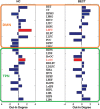Altered functional and effective connectivity in anticorrelated intrinsic networks in children with benign childhood epilepsy with centrotemporal spikes
- PMID: 27310959
- PMCID: PMC4998445
- DOI: 10.1097/MD.0000000000003831
Altered functional and effective connectivity in anticorrelated intrinsic networks in children with benign childhood epilepsy with centrotemporal spikes
Erratum in
-
Erratum: Medicine, Volume 95, Issue 24: Erratum.Medicine (Baltimore). 2016 Aug 7;95(31):e5074. doi: 10.1097/01.md.0000490009.39850.74. eCollection 2016 Aug. Medicine (Baltimore). 2016. PMID: 31265618 Free PMC article.
Abstract
There are 2 intrinsic networks in the human brain: the task positive network (TPN) and task negative network (alternately termed the default mode network, DMN) in which inverse correlations have been observed during resting state and event-related functional magnetic resonance imaging (fMRI). The antagonism between the 2 networks might indicate a dynamic interaction in the brain that is associated with development.To evaluate the alterations in the relations of the 2 networks in children with benign childhood epilepsy with centrotemporal spikes (BECTS), resting state fMRI was performed in 17 patients with BECTS and 17 healthy controls. The functional and effective connectivities of 29 nodes in the TPN and DMN were analyzed. Positive functional connectivity (FC) within the networks and negative FC between the 2 networks were observed in both groups.The patients exhibited increased FC within both networks, particularly in the frontoparietal nodes such as the left superior frontal cortex, and enhanced antagonism between the 2 networks, suggesting abnormal functional integration of the nodes of the 2 networks in the patients. Granger causality analysis revealed a significant difference in the degree of outflow to inflow in the left superior frontal cortex and the left ventral occipital lobe.The alterations observed in the combined functional and effective connectivity analyses might indicate an association of an abnormal ability to integrate information between the DMN and TPN and the epileptic neuropathology of BECTS and provide preliminary evidence supporting the occurrence of abnormal development in children with BECTS.
Conflict of interest statement
The authors have no conflicts of interest to disclose.
Figures




References
-
- Loiseau P, Duche B. Benign childhood epilepsy with centrotemporal spikes. Cleve Clin J Med 1989;56:S17–22. - PubMed
-
- Hughes JR. Benign epilepsy of childhood with centrotemporal spikes (BECTS): to treat or not to treat, that is the question. Epilepsy Behav 2010;19:197–203. - PubMed
-
- Monjauze C, Broadbent H, Boyd SG, et al. Language deficits and altered hemispheric lateralization in young people in remission from BECTS. Epilepsia 2011;52:e79–83. - PubMed
-
- Fox MD, Raichle ME. Spontaneous fluctuations in brain activity observed with functional magnetic resonance imaging. Nat Rev Neurosci 2007;8:700–11. - PubMed
Publication types
MeSH terms
LinkOut - more resources
Full Text Sources
Other Literature Sources
Medical
Research Materials

